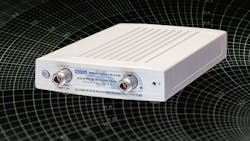An Introduction to the VNA and Vector Network Analysis (Download)
Most design engineers are familiar with tools of the trade such as voltmeters, oscilloscopes, signal generators, and spectrum analyzers. Some may not have had the opportunity to use a vector network analyzer (VNA). It’s the intent of this article to introduce VNA measurement and present a few typical applications.
Why is a VNA Useful?
Transmission lines can support RF propagation in either direction. Signals traveling along a transmission line may encounter localized impairments that aren’t precisely 50 Ω, such as connectors or transitions from coaxial to planar media (other impedances such as 75 Ω are common, but for the purposes of this explanation we will use 50 Ω). Each impairment generates a reflection that travels back toward the source along the transmission line.
